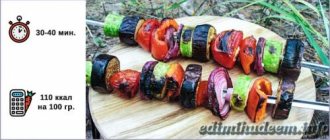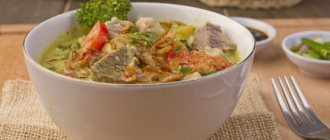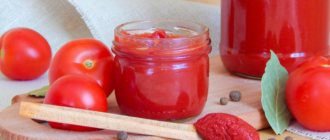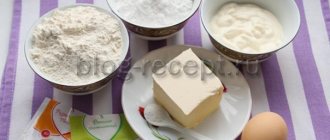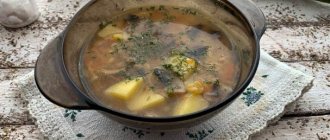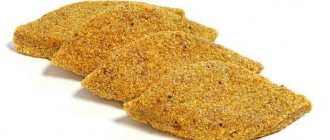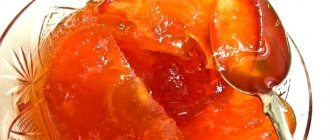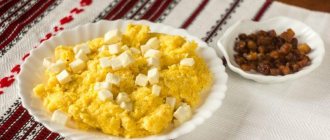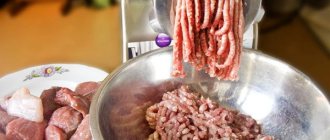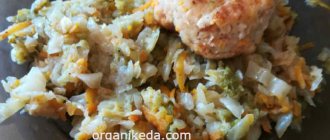4
Prepared by: Arutyunova Kristina
08/11/2017 Cooking time: 40 min
| Save | I cooked) | Estimate |
From time immemorial, horseradish has been a very useful seasoning that saved many from colds. Today I will share with you a recipe for making horseradish seasoning. We will cook “horseradish” with tomatoes.
Devices for grinding horseradish
To reduce the effect of oils on mucous membranes, it is better to clean and grate horseradish in the fresh air. If this is not possible, then during work you need to open the window and turn on the hood so that the particles evaporate faster.
For work, you may need any chopping devices that are in the kitchen.
The most difficult way is to grate, but unlike other devices, it is found in every home. Especially if you need to grate a small amount of horseradish. It must be grated on the finest grate so that it can be used for preparing various sauces.

Preparation for the winter
Powdered horseradish is one of the easiest preparations to use at any time of the year. Along with this, there is also a way to preserve the healing and taste qualities of this plant in winter, such as placing root crops in basements and sprinkling them with sand.
However, this option is more often used by owners of land plots and special premises, so it can hardly be called publicly available. To prepare horseradish for the winter, you can use classic recipes that involve sterilizing the preparations. The ability of vinegar to increase the shelf life of various seasonings is also useful here.
Article design: Oksana Grivina
Methods for grinding root vegetables
Cooks go to great lengths to reduce the negative consequences of working with horseradish. Someone puts on goggles and respirators, this process turns into fun entertainment for the whole family. But there are simpler options.
Grater and plastic bag
A simple and inexpensive method, but relatively labor-intensive and time-consuming. The process consists of:
- Root cleaning;
- The roots and grater are placed in a bag that closes tightly;
- The root is taken in the hand and rubbed, while being careful not to damage the integrity of the package;
- At the end of the work, the bag is untied and the resulting shavings are transferred to the desired container in which the horseradish will be stored or used for further cooking.
The disadvantage of this method is that it is difficult to work with and rubbing in a bag is inconvenient. But, despite this, the mucous membranes will not be exposed to burning oils.

How to prepare horseradish with lemon for the winter
Ingredients:
- 1.5 kg horseradish roots
- 3 tablespoons sugar
- 1 tablespoon salt
- 1 lemon
How to close horseradish with lemon:
1. Peel the horseradish rhizomes and rinse with water.
2. For a meat grinder with a fine grid, place a plastic bag over the outlet hole and secure with an elastic band so that the caustic fumes released do not interfere with your cooking.
3. Pass the horseradish through a meat grinder and mix with sugar and salt.
4. Pour boiling water over the horseradish to make a thick paste.
5. Stir quickly and immediately pour into small, clean jars with screw caps.
6. Squeeze a few drops of lemon juice into each jar.
7. Screw the lids on tightly and put them in the refrigerator.
You can store this homemade horseradish preparation for 2-3 months.
Meat grinder to the rescue
In a meat grinder, horseradish is processed quite quickly, but for large volumes you can resort to two main methods of grinding horseradish:
First freeze the roots, then grind them in a meat grinder. In this case, it is better to cut the roots into thin strips and put them in the freezer for 3-5 hours, then defrost them a little and process them;
When working with a modern electric meat grinder, there should be no problems with processing; the main thing is to put a food-grade plastic bag over the hole from which the twisted horseradish will come out and tie it tightly.

How to make Horseradish Seasoning
1
We start preparing the “horseradish” by rinsing the tomatoes under running water, then drying them with paper towels and removing the stems.
2
Now let's move on to the main ingredient. Horseradish root must be peeled, washed and minced.
3
We also pass the garlic and quartered tomatoes through a meat grinder. Next, add the previously chopped horseradish to the tomato-garlic mass. Stir, adding salt and sugar to taste. “Hrenovina” is ready, bon appetit!
Blender
It is better to use a stationary blender with a power of more than 700 W. The roots are washed and cleaned. For convenience, they are cut into small plates and placed in a blender bowl. The fruit is quite hard and fibrous, so you can add a little water to it without filling the bowl to the top. Water is not added immediately; if the spruce roots will be finely chopped, you don’t have to add water.
When the horseradish is chopped, you can transfer it to a suitable container, and wash the blender thoroughly with warm water. The advantage of this method is the speed of processing and the ability to use roots of any size and shape.

Preparation of dry seasoning
It is convenient to store horseradish in the form of a dry seasoning. To do this, the roots are cleaned and cut into thin slices. In a preheated oven to 50°C, place the horseradish in one layer on a baking sheet and leave to dry for 4-6 hours. After this, the horseradish is allowed to cool and crushed into powder using a blender, meat grinder or other convenient method. That's it, the seasoning is ready for use and storage.
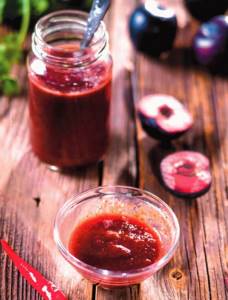
Instead of an oven, you can use an electric dryer.
We can conclude that it is quite possible to grate horseradish at home without tears, and quite quickly and conveniently.
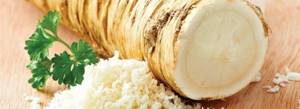
Horseradish is a useful plant that is widely used in cooking. The leaves are used in preserves, and the root is used in preparing all kinds of dishes and sauces. You can also buy ready-made paste in the store, but it is known that the plant, when crushed, loses most of its beneficial properties within 14–15 hours. For this reason, it is more rational to prepare the mass yourself and eat it as quickly as possible. The root needs to be grated before cooking, but this is where the main problem lies. Is it possible to do this at home without tears?
Where is horseradish used? Useful properties of the product
It's no secret that horseradish is used to make spicy seasonings. Horseradish and mustard have similar flavors. This vegetable adds a certain taste to any dish seasoned with it. Horseradish, whose beneficial properties are not limited to cooking, is also used in folk medicine. To increase appetite, you should consume it in small doses.
How is horseradish useful as an antiseptic? It contains special elements and essential oils that make the product an antiseptic. Horseradish is also a very nutritious supplement containing carbohydrates - 16%, nitrogen compounds - 3% and some fat. In terms of the amount of vitamin C, it occupies an intermediate position between lemon and rose hips, as well as currants. Among other substances there are compounds of potassium, calcium, phosphorus, iron, phytoncides, mustard oils, tar substances, starch. Carotene can be isolated from horseradish leaves.
Ailments that horseradish fights. Benefits in treatment
If you grind horseradish and preserve it in jars, many useful substances will disappear after a certain period of time. It is in this unhealthy form that we find it on supermarket trays or in grocery stores.
In its fresh form, horseradish is a strong digestive stimulant. It also treats inflammation of the genitourinary system, removes kidney stones, eliminates cystitis, rheumatism and gout. They can be used as a poultice for facial neuralgia, to treat whooping cough and sore throat. Be careful with your eyes as the product may cause some irritation.
And horseradish is not only known for this. The beneficial properties of the plant allow you to treat gastritis, catarrhal inflammation of the respiratory organs, and normalize acidity. In any form, horseradish prophylaxis is used for kidney ailments, liver and gastrointestinal diseases.
The plant is able to kill bacteria and slow down the growth of infectious diseases due to the phytoncides it contains.
Horseradish juice is useful for gargling, for toothaches, and for healing purulent skin inflammations. It also counteracts radiculitis, rheumatism, and seborrhea.
Recipes
Horseradish takes pride of place in the list of healthy foods. The beneficial properties of its juice, diluted with lemon, are manifested in the elimination of mucus in places where it accumulates. To do this, the mentioned composition in the form of gruel is consumed 1-2 times before noon. Another feature of the composition is increased urination during edema and dropsy. For the tincture, several lemons and about 200 g of fresh horseradish are used.
For chronic runny nose, use half a teaspoon of this remedy several times a day. It is advisable to abstain from food for half an hour. Fresh horseradish, collected from the garden, is consumed for about a week. And the mentioned infusion can be used for as long as desired.
For increased sweating: squeeze horseradish juice (about 30%) into a cup of water. We use a third of the portion of the composition several times a day.
To stimulate appetite, one spoonful of grated horseradish is poured into two glasses of boiled water. Use within 15 minutes. before meals, 50 ml.
If you hurt yourself, apply the leaves of the plant to the sore spot. This natural “plaster” also helps with dermatomycosis.
Horseradish in cosmetology
Horseradish is an excellent cosmetic product. To counteract freckles and age spots, a water tincture of horseradish is made. Then it is rubbed onto areas of the skin where diseases appear.
It is important to know!
We looked at the main characteristics of the horseradish plant. Its beneficial properties are used in cooking, traditional medicine, and cosmetology. However, with all this, it is not recommended to include horseradish in the diet during severe exacerbations of organ diseases and during pregnancy.
The dosage of the plant should be moderate, since excessive consumption of horseradish is fraught with high blood pressure or even blood loss.
Why is it so difficult to grate horseradish root?
It is much more difficult to grate horseradish without tears than onions. Irritated red eyes, salty streams running down my face, and even a swirl in my nose. Such unpleasant side effects can discourage any desire to independently prepare dishes from this useful plant. The fact is that it contains essential oils, which, when the root is crushed, quickly enter the air, making it burning and irritating to the mucous membranes. This is why it is so difficult to grate it by hand, especially in large quantities. In addition, the roots must be washed from dirt and cleaned.
Peeling horseradish is much easier than grating it, if only for the reason that less burning substances are released. To make cleaning easier, it is advisable to pre-soak the roots in cold water for 5-6 hours. It is best to wash under the tap using a brush or kitchen sponge. Remove the peel using a sharp knife, vegetable peeler or steel wool.
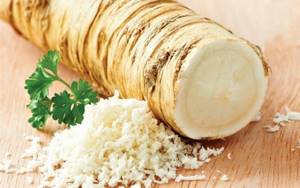
Turning horseradish root into fine shavings is not an easy task.
Delicious dishes with horseradish
Any of us has tried grandma's horseradish. This appetizer has a bitterness and spiciness due to horseradish and garlic, which are used for its preparation. It's time to learn how to cook it yourself for your family. If you have grown a lot of tomatoes, but you don’t have time to pickle them, then you should twist them and add them to the freezer. For the winter, this appetizer goes well with any main dish: potatoes, pasta, rice, buckwheat or beans. If you want to soften the bitterness and spiciness of a horseradish dish, you should add grated beets, lemon juice or honey.
Dishes with horseradish are common in Russian, Ukrainian and Belarusian cuisine. Green horseradish - a snack for the winter is spicy, it contains vitamins, and also something that can scare away any cold. In addition to the fact that horseradish contains vitamins, it also has a positive effect on human immunity.
Canapés with horseradish and ham are a great find for a hostess who has decided to please her guests at a festive dinner. Canapés are prepared quickly and easily. They can be decorated with greenery if desired.
This fiery snack is suitable for those who love spicy and bitter food. Of course, you can't eat it alone. You can eat it with potatoes, salad, vegetables or meat, or the simplest option is with bread.
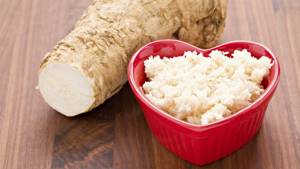
Grinding tools and optimal working conditions
To prevent this process from turning into a real test of endurance, we recommend doing this in the fresh air. On the street, the smell of essential oils evaporates faster, so there is less discomfort. If you decide to shred at home, then at least open a window or turn on the hood at full power.
The following tools and devices are suitable for grinding:
- sharp knife;
- fine grater;
- meat grinder;
- blender;
- food processor;
- juicer.
Grating horseradish is the most difficult thing to do. Here the risk of injury and discomfort arise to a greater extent. It is better to use a grater if you need to grate a small root, or when there are no other utensils.
You need to grate it on the finest grater, the one on which onions are usually grated. Then it will be in a pulp state and suitable for preparing hot paste-like sauces.
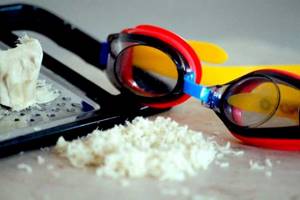
You can approach the process with humor and wear swimming goggles, which will protect your eyes from burning
It is much easier to twist the root in a meat grinder, but it will not be possible to achieve a porridge-like consistency. Pre-peeled root vegetables are cut into small portions. The ideal option is a blender or food processor. The machine will do everything for you efficiently and, importantly, quickly and without tears.
How to pickle horseradish for the winter - features of Russian cuisine
The original Russian taste of horseradish sauce is achieved if during the preparation process you do without vinegar, table or fruit. Cooking time is also important - it is best if the seasoning is prepared in parallel with the dishes with which it is served. In this case, you will retain the full strength of aroma and taste, as well as the maximum of nutrients. After just a couple of days, the seasoning will lose most of its pungency and flavor nuances.
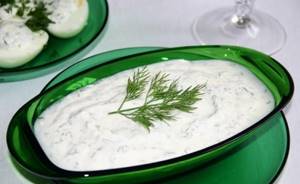
But in our fast-paced age, there is often a need for preliminary preparation and preservation, because there is not always time for kitchen fuss. In this case, you will need a recipe on how to properly pickle horseradish for the winter. We wash it under running water and finely scrape off the skin. The thinner the layer you remove, the more nutrients you will retain in the roots. By the way, on our website you will also find a recipe for pickling beets.
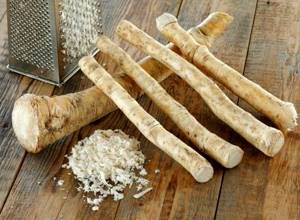
Then use a blender or meat grinder to grind the roots. A significant amount of phytoncides and lysozyme (vegetable protein with a bactericidal effect) can cause irritation of the mucous membranes of the nose and eyes. Therefore, it is advisable to put a plastic bag on the meat grinder and attach it with ties or an elastic band, and collect the grated horseradish directly into it.
Grinding methods at home, their pros and cons
Inventive cooks come up with everything they can to minimize the discomfort when grinding this sharp, burning root. They put on a diving mask, goggles, and even a gas mask. The whole process of grinding horseradish turns into a comedy performance to the delight of those present in the house. But there are less fun ways to turn the stinging root into pulp without tears or sobs. Let's look at each of them.
Delicious recipe! Salad with beef, tomatoes and cucumbers
Grating with a food bag
This is probably one of the oldest methods. Modern housewives practically don’t use it anymore due to its labor-intensive and time-consuming nature compared to other methods. If you don’t have any suitable tools in the kitchen other than a grater, then you will also need a regular food bag for storing food. Of course, it should be transparent, clean and quite spacious.
- Pre-wash and clean the roots in any convenient way.
- Place the grater and peeled horseradish in a bag.
- Tie the bag tightly.
- Grasp the root on top of the bag with your right hand and hold the grater with your left (or vice versa if you're left-handed).
- Grate the root, being careful not to damage the bag.
- When the job is done, untie the bag.
- Transfer the resulting slurry to the desired container.
- Horseradish is ready for further processing.

Horseradish, finely grated, is suitable for making pasta and sauce
Do not use bags not intended for food storage. The ideal option is a spacious transparent cellophane bag, in which vegetables or bread are usually placed.
The disadvantage of this method is that it is quite difficult to grate a large amount of horseradish. Moreover, doing this in a package is not very convenient. The advantage is that substances that irritate the mucous membranes remain in the bag and the grinding process takes place practically without tears.
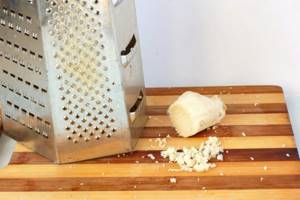
It is better to use a grater only if you need to grate a small piece of horseradish
Freezing and grinding in a meat grinder
It is much easier to grind horseradish in a meat grinder. To prevent it from eating your eyes out during grinding, it must first be frozen. When frozen, it does not lose its beneficial properties, it becomes soft and less pungent.
Before putting the peeled roots in the freezer, it is advisable to immediately cut them into small pieces. Then they are taken out, defrosted and started chopping. How to do:
- Wash and clean the horseradish.
- Cut into pieces 3–4 cm long.
- Place in a plastic bag and place in the freezer for 4-5 hours
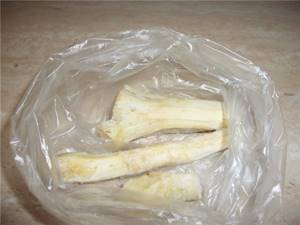
The peeled roots are placed in a bag and sent to the freezer.
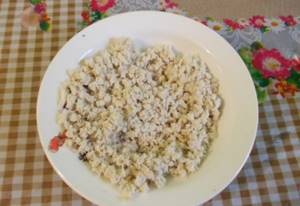
Using a meat grinder will not grind the root into pulp.
The big advantage of this method is that after defrosting the root becomes softer and much easier to twist. This is doubly good if you have an old Soviet meat grinder and have to work with your hands. The downside of this method is that twisting a large amount of horseradish by hand is not as easy as it seems. In addition, you first need to freeze the root, then defrost it, etc.
Twisting in a meat grinder + bag
If you are the happy owner of a modern electric meat grinder, then grinding horseradish will not be difficult at all. In addition to the miracle device, you will also need a spacious food bag. It is he who will save you from the pungent aroma and tears. The bag is placed over the opening of the meat grinder, from which the ground mass comes out. The ends are tied tightly or secured with an elastic band.
Since peeled horseradish tends to darken when exposed to air, we recommend placing it in a deep bowl and pouring cold water over it.

To prevent the peeled root from darkening, it is poured with cold water.
- Cut the pre-washed and peeled horseradish into pieces.
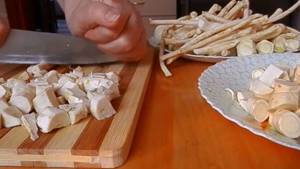
To make the root easier to grind in a meat grinder, it needs to be chopped into small pieces
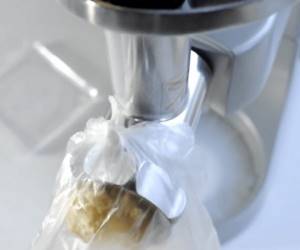
The bag must be tied tightly so that it does not slip off when twisting.
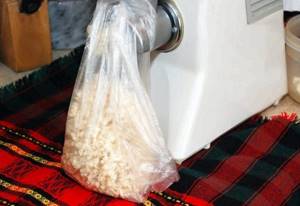
Due to the fact that the ground particles immediately fall into the bag, there is no unpleasant sensation
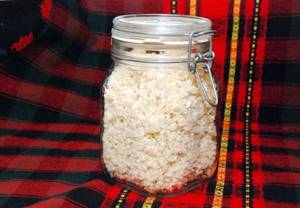
It is better not to store crushed horseradish for longer than 15 hours - it begins to lose its beneficial properties
As you can see, with the help of a modern electric meat grinder and a little trick, you can really grind horseradish easily and, importantly, without tears. In this way, you can use a regular manual meat grinder.
To make this method even easier, place the bowl directly into the bag. The crushed pieces will fall directly into the container.

With this trick, the chopped horseradish root immediately falls into the bowl
Another way to twist
There is a very interesting know-how on grinding horseradish. You will need a modern electric meat grinder, a narrow plastic bag without handles, a half-liter glass jar and two rubber bands. There is no need to freeze the root, just cut it into small pieces. Do the following:
- Cut the welded end of the bag to create a “sleeve”.
- Place one end of the “sleeve” over the neck of the jar and secure with an elastic band.
- Move the jar closer to the outlet of the meat grinder.
- Place the free end of the “sleeve” over the outlet hole and also secure with an elastic band.
- Turn on the electrical appliance and twist the horseradish.
Using this simple method, the chopped root goes directly into the jar. You don’t suffer or cry at all, but just quickly pour the chopped root into the meat grinder and enjoy the process. This method is good if you need to twist a large amount of horseradish, and requires virtually no effort on your part.
Video: how to quickly grind horseradish in a meat grinder without tears
Easy grinding in a blender
You will need a stand blender with a glass or plastic blending bowl. Pay attention to its power - devices with a power of less than 700 W are unlikely to cope with this task.
Important: do not fill the bowl to the very top, tightly stuffing it with pieces of horseradish. The device will not completely chop the roots and may even break. It is also useless to throw in a few pieces and turn on the blender - it will not grind them.
So, you have a good stand-up blender and some horseradish roots that need processing. In this case, it is important to completely cut off the hard skin when cleaning - it will be easier to chop and you will get a uniform consistency. You will also need a cutting board and a knife, since the peeled roots need to be cut into circles. If the root is large, it is better to cut it lengthwise into two parts and then cut into pieces.
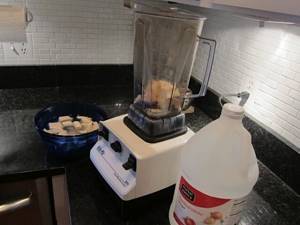
Using a powerful blender, you can quickly chop horseradish without spilling even a tear.
Since horseradish root itself is dry and hard, it is quite difficult to chop it. To make his work easier, we recommend adding a little water.
- Wash and clean the roots.
- Cut into circles, 0.5 cm thick.
- Place the chopped horseradish in the chopper bowl.
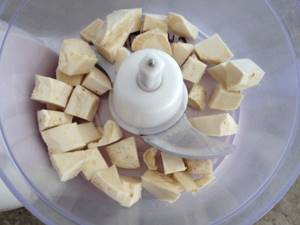
The sharp blades of the chopper will finely chop the root
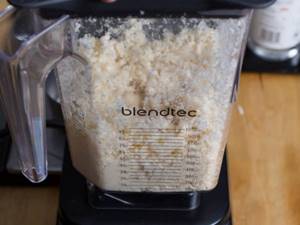
The blender will grind the horseradish efficiently, significantly saving your effort and time.
You don’t have to pour water right away. Look at the situation and how the chopper copes. If the motor turns easily, do not add water.

To grind horseradish faster and more efficiently, you should add a little water to the bowl.
A huge advantage of this method is that even small roots are suitable for processing. There are practically no disadvantages. But if you decide to add water, then keep in mind that the crushed mass will be a little liquid and is not suitable for every dish.
You can also use a regular immersion blender, in which the chopper is attached to a handle with a motor.
Grinding in a food processor or juicer: how to do it correctly
Probably the easiest and fastest way. A food processor will easily cope with this task. The big advantage is that it is not necessary to first cut the root into small pieces. This will save significant time.
So, you will need a nozzle with small holes. Instructions:
- Wash and clean the roots.
- Turn on the combine.
- Place the peeled root in a special receptacle and press on it.
- Push with a special pusher.
- Continue in this manner until everything is chopped.
- Turn off the combine.
- Place the chopped horseradish into a bowl.
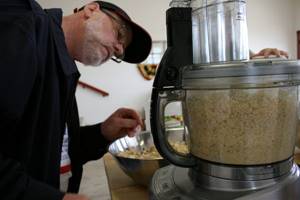
You can use a food processor to chop large quantities of horseradish.
As you can see, everything is very simple, quick and without tears.
If you don't have a food processor, but have a powerful juicer for hard fruits and vegetables, feel free to use it. The roots can be cut into pieces or left as is. As in the case of fruits and vegetables, you will get juice and cake separately. Once you have chopped all the horseradish, simply mix everything together in a bowl until you get a uniform consistency. The big advantage of this method is that the horseradish is ground very finely, literally into a pulp. No deficiencies found.
Preparation of dry seasoning in powder form: recipe
Horseradish is also prepared in dry form. Most often, the dried roots are ground into powder and used to make hot sauces. Dry in a conventional oven at a temperature of 50–60 °C or in a special electric dryer for fruits and vegetables. Grind into flour using a manual or electric coffee grinder or blender. You can also crush it in a mortar.
- Wash and clean the roots.
- Cut into thin slices.
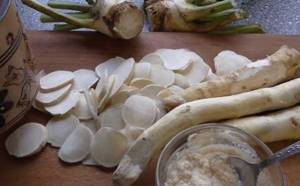
Thinly chopped roots are suitable for drying.

To help moisture escape faster, you can place a wooden stick between the door and the oven itself.
Delicious recipe! Delicious green tomatoes for the winter, sweet recipes
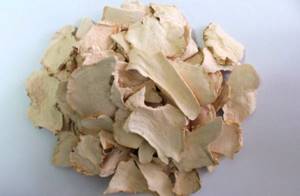
After drying, horseradish slices become brittle and easily grind
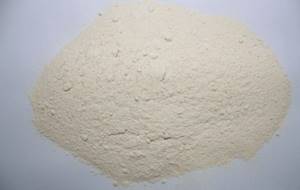
Dried horseradish flour can be stored for 2 years
You can first crush the horseradish in a mortar and then grind it in a blender or coffee grinder. This seasoning is stored in tightly closed glass jars all winter and used as needed. Before you start cooking, the powder is diluted in water to the desired consistency.
In order to obtain fine flour without pieces, we recommend sifting the resulting powder through a sieve. If there are a lot of solid pieces, grind them again or grind them in a mortar.
You can also dry the root, grated on a coarse grater or in a food processor using an attachment with larger holes. Then the drying process will be reduced by at least half.
Video: how to prepare horseradish powder
Natural horseradish with lemon
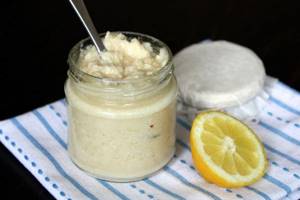
Without horseradish, it is difficult to imagine Easter and other wonderful holidays with many hearty dishes. It’s good to have horseradish seasoning in the refrigerator for everyday snacks, adding it to sauces, first courses, and sandwiches.
Horseradish relish is often made with beets. But such a product is not universal enough. If you don’t like beets or plan to add prepared horseradish to dishes where they are inappropriate, it is better to prepare the seasoning without any admixtures. Natural horseradish with lemon has a natural white color. It is perfectly stored throughout the winter without losing its taste and aroma.
If you don’t have horseradish to prepare for the winter, look through the list of advertisements and purchase the root vegetable from farmers who sell their home harvest in the fall.
Natural horseradish with lemon. Ingredients:
- horseradish roots – 400 g
- lemon juice - from 1 lemon
- ice water – 1 glass (or 1 bag of ice cubes)
- sugar – 2 tbsp. spoons
- salt – 2 teaspoons
Additionally:
- vegetable oil – 1 tbsp. spoon in each jar
Natural horseradish with lemon. Preparation:
- Peel the horseradish roots and place them in a bowl of cold water for at least 30 minutes. Then cut into pieces and place in the bowl of a food processor, covering with ice cubes.
- If your food processor can't handle crushing the ice cubes, just pour in a glass of ice water. Add sugar, salt, pour in freshly squeezed lemon juice and grind everything together to a thick paste. If the paste is too thick, add a little more purified water (about 150 g) and beat again until smooth.
- With ice (or cold water), the horseradish will release less essential oils, and you will crush it without tears from your eyes.
- Place natural horseradish with lemon in dry sterile jars with a capacity of about 300 g, pour 1 tablespoon of vegetable oil on top, which prevents spoilage, and seal tightly or screw on the lids.
- Store the seasoning in a cool, dark pantry. After opening, store the jar with the preparation in the refrigerator.
On a note!
Horseradish gives food a spicy, pungent flavor, and also has a good effect on the gastrointestinal tract, improving its functioning.
Horseradish roots are very healing, they have medicinal properties and are used as a medicine internally and externally. It is also capable of removing toxins.
Horseradish is also widely used for cosmetic purposes, promoting skin rejuvenation and stimulating hair growth.
Bon appetit and delicious preparations!
How to wash your hands after working with horseradish
It’s probably unnecessary to say that when working with horseradish you need to wear gloves. Since most housewives do not do this, after cleaning, rubbing and other manipulations, their hands are usually dirty. The fact is that horseradish juice tends to darken in the air, because of this the skin of the hands and nails get dirty in a dark color. The pigment penetrates into cracks and hangnails, so you won’t be able to completely wash your hands with warm water and soap. Lemon juice, table vinegar, hydrogen peroxide, and ammonia will help restore cleanliness. Here are some effective ways:
- Lemon. To remove minor stains, rub your hands with a slice of lemon. To whiten your nails, cut a lemon in half and soak your fingers in both halves for a few minutes. If you have wounds and hangnails on your hands, then it is better not to use this method. The acid irritates the lesions on the skin and a strong burning sensation is felt.
- Vinegar. Apply a little table vinegar to a clean sponge and scrub your hands. Do not use this method if your skin is damaged.
- Hydrogen peroxide. Apply the product to a cotton pad and scrub your hands until they are clean and beautiful again.
- Hand bath. Make a warm hand bath from 2 tbsp. water, 1 tsp. ammonia, 2 tsp. hydrogen peroxide and 3 tbsp. spoons of dishwashing detergent. Soak your hands in the solution for 10 minutes and then scrub with a brush. If you can't stand the smell of ammonia, then use only peroxide.
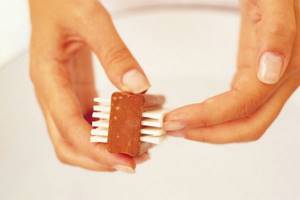
A brush will help you wash your hands after peeling horseradish.
With lemon
The combination of hot horseradish with lemon, which has a sharp acid and a specific aroma, makes the seasoning especially piquant.
It is prepared from the following ingredients:
- horseradish roots – 1-1.5 kg;
- lemon (medium size) – 1 fruit;
- sugar – 2-3 tbsp. l.;
- salt - to taste;
- water – up to 1 liter (depending on the desired consistency).
Sequence of sauce preparation:
- Peel the horseradish from the top layer of peel, chop and cover in a separate container.
- Boil the water and then let it cool (to +80°C).
- Pour the prepared horseradish with this liquid with the addition of salt and sugar.
- Place the resulting seasoning mixture into small glass containers and add 1 tsp to each of them. freshly squeezed lemon juice.
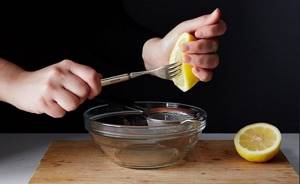
- Place the filled dishes in the refrigerator for storage and dosed use with meat and fish dishes. In this case, it is allowed to supplement such seasoning with sour cream and mayonnaise.
Video: how to clean and grate horseradish
As you can see, grating horseradish is not as difficult as it seems at first glance. Thanks to our tips, chopping this pungent root vegetable can even turn into a very interesting activity. Therefore, feel free to prepare dishes from horseradish and delight your family with delicious, healthy food.
Horseradish is a useful plant that is widely used in cooking. The leaves are used in preserves, and the root is used in preparing all kinds of dishes and sauces. You can also buy ready-made paste in the store, but it is known that the plant, when crushed, loses most of its beneficial properties within 14–15 hours. For this reason, it is more rational to prepare the mass yourself and eat it as quickly as possible. The root needs to be grated before cooking, but this is where the main problem lies. Is it possible to do this at home without tears?
Simple horseradish dishes
Horseradish is a perennial plant.
Its roots and leaves are used to prepare various dishes - simple and complex. The roots are used to prepare various sauces. It is added to meat and cold appetizers, main courses. The simplest dish is horseradish, pickled for the winter. If you pickle it at home, you don’t have to buy it at the store. Horseradish and plum appetizer - perfect for potatoes or meat dishes. You can find horseradish recipes with photos on our website and prepare them yourself not only for lunch and dinner, but also for the winter. Horseradish with beets will be an ideal preparation for the winter. You will need a minimum of ingredients so that you can enjoy a delicious snack in winter. Some people even prepare kvass with horseradish. This kvass can be added to okroshka, without the need to add horseradish.
Not only horseradish root is used for canning, but also its leaves. To give pickled cucumbers a specific taste and make them crispy, you should add a leaf or part of horseradish to the jar. Horseradish has antiseptic properties, so the likelihood that the lid will swell or the pickles will begin to sour is unlikely.
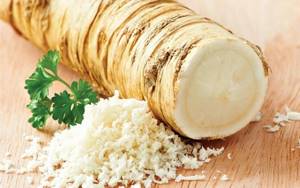
Why is it so difficult to grate horseradish root?
It is much more difficult to grate horseradish without tears than onions. Irritated red eyes, salty streams running down my face, and even a swirl in my nose. Such unpleasant side effects can discourage any desire to independently prepare dishes from this useful plant. The fact is that it contains essential oils, which, when the root is crushed, quickly enter the air, making it burning and irritating to the mucous membranes. This is why it is so difficult to grate it by hand, especially in large quantities. In addition, the roots must be washed from dirt and cleaned.
Peeling horseradish is much easier than grating it, if only for the reason that less burning substances are released. To make cleaning easier, it is advisable to pre-soak the roots in cold water for 5-6 hours. It is best to wash under the tap using a brush or kitchen sponge. Remove the peel using a sharp knife, vegetable peeler or steel wool.
Turning horseradish root into fine shavings is not an easy task.
Grinding tools and optimal working conditions
To prevent this process from turning into a real test of endurance, we recommend doing this in the fresh air. On the street, the smell of essential oils evaporates faster, so there is less discomfort. If you decide to shred at home, then at least open a window or turn on the hood at full power.
The following tools and devices are suitable for grinding:
- sharp knife;
- fine grater;
- meat grinder;
- blender;
- food processor;
- juicer.
Grating horseradish is the most difficult thing to do. Here the risk of injury and discomfort arise to a greater extent. It is better to use a grater if you need to grate a small root, or when there are no other utensils.
You need to grate it on the finest grater, the one on which onions are usually grated. Then it will be in a pulp state and suitable for preparing hot paste-like sauces.
You can approach the process with humor and wear swimming goggles, which will protect your eyes from burning
It is much easier to twist the root in a meat grinder, but it will not be possible to achieve a porridge-like consistency. Pre-peeled root vegetables are cut into small portions. The ideal option is a blender or food processor. The machine will do everything for you efficiently and, importantly, quickly and without tears.
Grinding methods at home, their pros and cons
Inventive cooks come up with everything they can to minimize the discomfort when grinding this sharp, burning root. They put on a diving mask, goggles, and even a gas mask. The whole process of grinding horseradish turns into a comedy performance to the delight of those present in the house. But there are less fun ways to turn the stinging root into pulp without tears or sobs. Let's look at each of them.
Grating with a food bag
This is probably one of the oldest methods. Modern housewives practically don’t use it anymore due to its labor-intensive and time-consuming nature compared to other methods. If you don’t have any suitable tools in the kitchen other than a grater, then you will also need a regular food bag for storing food. Of course, it should be transparent, clean and quite spacious.
- Pre-wash and clean the roots in any convenient way.
- Place the grater and peeled horseradish in a bag.
- Tie the bag tightly.
- Grasp the root on top of the bag with your right hand and hold the grater with your left (or vice versa if you're left-handed).
- Grate the root, being careful not to damage the bag.
- When the job is done, untie the bag.
- Transfer the resulting slurry to the desired container.
- Horseradish is ready for further processing.
Horseradish, finely grated, is suitable for making pasta and sauce
Do not use bags not intended for food storage. The ideal option is a spacious transparent cellophane bag, in which vegetables or bread are usually placed.
The disadvantage of this method is that it is quite difficult to grate a large amount of horseradish. Moreover, doing this in a package is not very convenient. The advantage is that substances that irritate the mucous membranes remain in the bag and the grinding process takes place practically without tears.
It is better to use a grater only if you need to grate a small piece of horseradish
Freezing and grinding in a meat grinder
It is much easier to grind horseradish in a meat grinder. To prevent it from eating your eyes out during grinding, it must first be frozen. When frozen, it does not lose its beneficial properties, it becomes soft and less pungent.
Before putting the peeled roots in the freezer, it is advisable to immediately cut them into small pieces. Then they are taken out, defrosted and started chopping. How to do:
- Wash and clean the horseradish.
- Cut into pieces 3–4 cm long.
- Place in a plastic bag and place in the freezer for 4-5 hours
The peeled roots are placed in a bag and sent to the freezer.
Using a meat grinder will not grind the root into pulp.
The big advantage of this method is that after defrosting the root becomes softer and much easier to twist. This is doubly good if you have an old Soviet meat grinder and have to work with your hands. The downside of this method is that twisting a large amount of horseradish by hand is not as easy as it seems. In addition, you first need to freeze the root, then defrost it, etc.
Twisting in a meat grinder + bag
If you are the happy owner of a modern electric meat grinder, then grinding horseradish will not be difficult at all. In addition to the miracle device, you will also need a spacious food bag. It is he who will save you from the pungent aroma and tears. The bag is placed over the opening of the meat grinder, from which the ground mass comes out. The ends are tied tightly or secured with an elastic band.
Since peeled horseradish tends to darken when exposed to air, we recommend placing it in a deep bowl and pouring cold water over it.
To prevent the peeled root from darkening, it is poured with cold water.
Delicious recipe! Recipe for baking chicken in the oven
- Cut the pre-washed and peeled horseradish into pieces.
To make the root easier to grind in a meat grinder, it needs to be chopped into small pieces
The bag must be tied tightly so that it does not slip off when twisting.
Due to the fact that the ground particles immediately fall into the bag, there is no unpleasant sensation
It is better not to store crushed horseradish for longer than 15 hours - it begins to lose its beneficial properties
As you can see, with the help of a modern electric meat grinder and a little trick, you can really grind horseradish easily and, importantly, without tears. In this way, you can use a regular manual meat grinder.
To make this method even easier, place the bowl directly into the bag. The crushed pieces will fall directly into the container.
With this trick, the chopped horseradish root immediately falls into the bowl
Another way to twist
There is a very interesting know-how on grinding horseradish. You will need a modern electric meat grinder, a narrow plastic bag without handles, a half-liter glass jar and two rubber bands. There is no need to freeze the root, just cut it into small pieces. Do the following:
- Cut the welded end of the bag to create a “sleeve”.
- Place one end of the “sleeve” over the neck of the jar and secure with an elastic band.
- Move the jar closer to the outlet of the meat grinder.
- Place the free end of the “sleeve” over the outlet hole and also secure with an elastic band.
- Turn on the electrical appliance and twist the horseradish.
Using this simple method, the chopped root goes directly into the jar. You don’t suffer or cry at all, but just quickly pour the chopped root into the meat grinder and enjoy the process. This method is good if you need to twist a large amount of horseradish, and requires virtually no effort on your part.
Video: how to quickly grind horseradish in a meat grinder without tears
Easy grinding in a blender
You will need a stand blender with a glass or plastic blending bowl. Pay attention to its power - devices with a power of less than 700 W are unlikely to cope with this task.
Important: do not fill the bowl to the very top, tightly stuffing it with pieces of horseradish. The device will not completely chop the roots and may even break. It is also useless to throw in a few pieces and turn on the blender - it will not grind them.
So, you have a good stand-up blender and some horseradish roots that need processing. In this case, it is important to completely cut off the hard skin when cleaning - it will be easier to chop and you will get a uniform consistency. You will also need a cutting board and a knife, since the peeled roots need to be cut into circles. If the root is large, it is better to cut it lengthwise into two parts and then cut into pieces.
Using a powerful blender, you can quickly chop horseradish without spilling even a tear.
Since horseradish root itself is dry and hard, it is quite difficult to chop it. To make his work easier, we recommend adding a little water.
- Wash and clean the roots.
- Cut into circles, 0.5 cm thick.
- Place the chopped horseradish in the chopper bowl.
The sharp blades of the chopper will finely chop the root
The blender will grind the horseradish efficiently, significantly saving your effort and time.
You don’t have to pour water right away. Look at the situation and how the chopper copes. If the motor turns easily, do not add water.
To grind horseradish faster and more efficiently, you should add a little water to the bowl.
A huge advantage of this method is that even small roots are suitable for processing. There are practically no disadvantages. But if you decide to add water, then keep in mind that the crushed mass will be a little liquid and is not suitable for every dish.
You can also use a regular immersion blender, in which the chopper is attached to a handle with a motor.
Grinding in a food processor or juicer: how to do it correctly
Probably the easiest and fastest way. A food processor will easily cope with this task. The big advantage is that it is not necessary to first cut the root into small pieces. This will save significant time.
So, you will need a nozzle with small holes. Instructions:
- Wash and clean the roots.
- Turn on the combine.
- Place the peeled root in a special receptacle and press on it.
- Push with a special pusher.
- Continue in this manner until everything is chopped.
- Turn off the combine.
- Place the chopped horseradish into a bowl.
You can use a food processor to chop large quantities of horseradish.
As you can see, everything is very simple, quick and without tears.
If you don't have a food processor, but have a powerful juicer for hard fruits and vegetables, feel free to use it. The roots can be cut into pieces or left as is. As in the case of fruits and vegetables, you will get juice and cake separately. Once you have chopped all the horseradish, simply mix everything together in a bowl until you get a uniform consistency. The big advantage of this method is that the horseradish is ground very finely, literally into a pulp. No deficiencies found.
Preparation of dry seasoning in powder form: recipe
Horseradish is also prepared in dry form. Most often, the dried roots are ground into powder and used to make hot sauces. Dry in a conventional oven at a temperature of 50–60 °C or in a special electric dryer for fruits and vegetables. Grind into flour using a manual or electric coffee grinder or blender. You can also crush it in a mortar.
- Wash and clean the roots.
- Cut into thin slices.
Thinly chopped roots are suitable for drying.
To help moisture escape faster, you can place a wooden stick between the door and the oven itself.
After drying, horseradish slices become brittle and easily grind
Dried horseradish flour can be stored for 2 years
You can first crush the horseradish in a mortar and then grind it in a blender or coffee grinder. This seasoning is stored in tightly closed glass jars all winter and used as needed. Before you start cooking, the powder is diluted in water to the desired consistency.
In order to obtain fine flour without pieces, we recommend sifting the resulting powder through a sieve. If there are a lot of solid pieces, grind them again or grind them in a mortar.
You can also dry the root, grated on a coarse grater or in a food processor using an attachment with larger holes. Then the drying process will be reduced by at least half.
Video: how to prepare horseradish powder
With beets
The combination of hot-tasting horseradish with juicy beets allows you to make various dishes softer.
Classic recipe
You can prepare this classic seasoning using the following ingredients:
- horseradish (freshly dug) – 200 g;
- beets – 100 g;
- sugar – 1 tbsp. l.;
- salt – 1 tsp;
- vinegar - 2 tbsp. l.;
- water – 200 ml.

Step-by-step preparation:
- Preparing the marinade by boiling water along with salt, sugar, vinegar and then cooling.
- Boiling, peeling the beets and chopping them on a fine grater.
- Preparation of horseradish roots using standard technology.
- Mixing prepared products (beets, horseradish) and infusing the mixture for 30 minutes. with further addition of warm marinade to it.
- Distributing the finished seasoning into pre-sterilized containers, sealing them tightly and placing them in a cold place after complete cooling.
With sterilization
Sterilization is a win-win way to extend the shelf life of products.
To use it, you need to take into account some of the subtleties of the process of preparing such basic components:
- horseradish roots and red beets (burgundy color) – 0.5 kg each;
- granulated sugar, table salt - 1 tsp each;
- vinegar (9%) – 250 ml;
- water – about 400 ml.
The next steps are:
- Boiling the beetroot, then cutting into small slices and grating on a coarse grater.
- Grinding peeled horseradish roots using a meat grinder.
- Prepare brine from the remaining ingredients (water, salt, sugar, vinegar).
- Mixing prepared main products (horseradish, beets) and adding brine to them.
- Filling glass jars with this preparation, followed by sterilization for 15-20 minutes.
- Hermetically seal the containers with metal lids, and after cooling, place them in a cold place.
With beets and ground pepper
Fans of spicy dishes enhance the heat of horseradish with the spicy taste and aroma of black pepper. Juicy colorful beets also add variety to this harmony.
In the absence of contraindications for the use of such a fiery mixture, you can prepare a seasoning using these and other products , namely:
- fresh horseradish roots and beets – 250 g each;
- ground pepper (black, red) – 0.5 tsp;
- vinegar (apple, wine) – 125 ml;
- salt – 30 g;
- sugar – 60 g;
- vegetable oil – 150 g.
Seasoning preparation step by step:
- Wash the horseradish and soak in water for 12 hours (or overnight).
- After this, keep it in the freezer for a while to facilitate subsequent peeling and then chopping.
- Boil the beets, peel and grind until they become shavings.
- Combine these prepared ingredients, season them with the remaining spices, except vinegar.
- Boil the resulting mass for 2-5 minutes, then add vinegar and stir again.
- Place the prepared seasoning in sterile glass containers, seal them hermetically and let it brew. After 20 days, this preservation is ready for use.
How to wash your hands after working with horseradish
It’s probably unnecessary to say that when working with horseradish you need to wear gloves. Since most housewives do not do this, after cleaning, rubbing and other manipulations, their hands are usually dirty. The fact is that horseradish juice tends to darken in the air, because of this the skin of the hands and nails get dirty in a dark color. The pigment penetrates into cracks and hangnails, so you won’t be able to completely wash your hands with warm water and soap. Lemon juice, table vinegar, hydrogen peroxide, and ammonia will help restore cleanliness. Here are some effective ways:
- Lemon. To remove minor stains, rub your hands with a slice of lemon. To whiten your nails, cut a lemon in half and soak your fingers in both halves for a few minutes. If you have wounds and hangnails on your hands, then it is better not to use this method. The acid irritates the lesions on the skin and a strong burning sensation is felt.
- Vinegar. Apply a little table vinegar to a clean sponge and scrub your hands. Do not use this method if your skin is damaged.
- Hydrogen peroxide. Apply the product to a cotton pad and scrub your hands until they are clean and beautiful again.
- Hand bath. Make a warm hand bath from 2 tbsp. water, 1 tsp. ammonia, 2 tsp. hydrogen peroxide and 3 tbsp. spoons of dishwashing detergent. Soak your hands in the solution for 10 minutes and then scrub with a brush. If you can't stand the smell of ammonia, then use only peroxide.
A brush will help you wash your hands after peeling horseradish.

